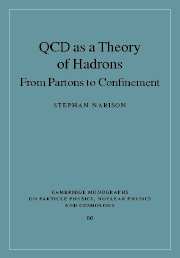Book contents
- Frontmatter
- Contents
- About Stephan Narison
- Outline of the book
- Preface
- Acknowledgements
- Part I General introduction
- Part II QCD gauge theory
- Part III MS-bar scheme for QCD and QED
- Part IV Deep inelastic scatterings at hadron colliders
- Part V Hard processes in e+e– collisions
- Part VI Summary of QCD tests and αs measurements
- Part VII Power corrections in QCD
- Part VIII QCD two-point functions
- Part IX QCD non-perturbative methods
- Part X QCD spectral sum rules
- 47 Introduction
- 48 Theoretical foundations
- 49 Survey of QCD spectral sum rules
- 50 Weinberg and DMO sum rules
- 51 The QCD coupling αs
- 52 The QCD condensates
- 53 Light and heavy quark masses, etc
- 54 Hadron spectroscopy
- 55 D, B and Bc exclusive weak decays
- 56 B0s-B̄0s Mixing, Kaon Cp Violation
- 57 Thermal behaviour of QCD
- 58 More on spectral sum rules
- Part XI Appendices
- Bibliography
- Index
57 - Thermal behaviour of QCD
from Part X - QCD spectral sum rules
- Frontmatter
- Contents
- About Stephan Narison
- Outline of the book
- Preface
- Acknowledgements
- Part I General introduction
- Part II QCD gauge theory
- Part III MS-bar scheme for QCD and QED
- Part IV Deep inelastic scatterings at hadron colliders
- Part V Hard processes in e+e– collisions
- Part VI Summary of QCD tests and αs measurements
- Part VII Power corrections in QCD
- Part VIII QCD two-point functions
- Part IX QCD non-perturbative methods
- Part X QCD spectral sum rules
- 47 Introduction
- 48 Theoretical foundations
- 49 Survey of QCD spectral sum rules
- 50 Weinberg and DMO sum rules
- 51 The QCD coupling αs
- 52 The QCD condensates
- 53 Light and heavy quark masses, etc
- 54 Hadron spectroscopy
- 55 D, B and Bc exclusive weak decays
- 56 B0s-B̄0s Mixing, Kaon Cp Violation
- 57 Thermal behaviour of QCD
- 58 More on spectral sum rules
- Part XI Appendices
- Bibliography
- Index
Summary
The QCD phases
We study here the uses of QCD spectral sum rules (QSSR) in a matter with non-zero temperature T and non-zero chemical potential ν (so-called Quark-Gluon Plasma (QGP)). Since the corresponding critical temperature for the colour deconfinement is expected to be rather small (Tc ≤ 1 GeV), these new states of matter can be investigated in high-energy hadron collisions. At high enough temperature T ≥ Tc ≈ 150 – 200 MeV corresponding to a vacuum pressure of about 500 MeV/fm3, QGP phase occurs and can be understood without confinement. In this phase, one also expects that chiral symmetry is restored (chiral symmetry restoration). However, it is a priori unclear, if the QGP phase and the chiral symmetry restoration occurs at the same temperature or not. Untuitively, one can expect that the deconfinement phase occurs before the chiral symmetry restoration. An attempt to show that the two phases are reached at the same temperature has been made in [839] using the FESR version of the Weinberg sum rules, which we shall discuss later on, where the constraint has been obtained by assuming that in the QGP phase, the continuum threshold starts from zero. In the QGP phase, the thermodynamics of the plasma is governed by the Stefan–Boltzmann law, as in an ordinary black body transition. This feature has been confirmed by a large number of lattice simulations.
- Type
- Chapter
- Information
- QCD as a Theory of HadronsFrom Partons to Confinement, pp. 681 - 695Publisher: Cambridge University PressPrint publication year: 2004



